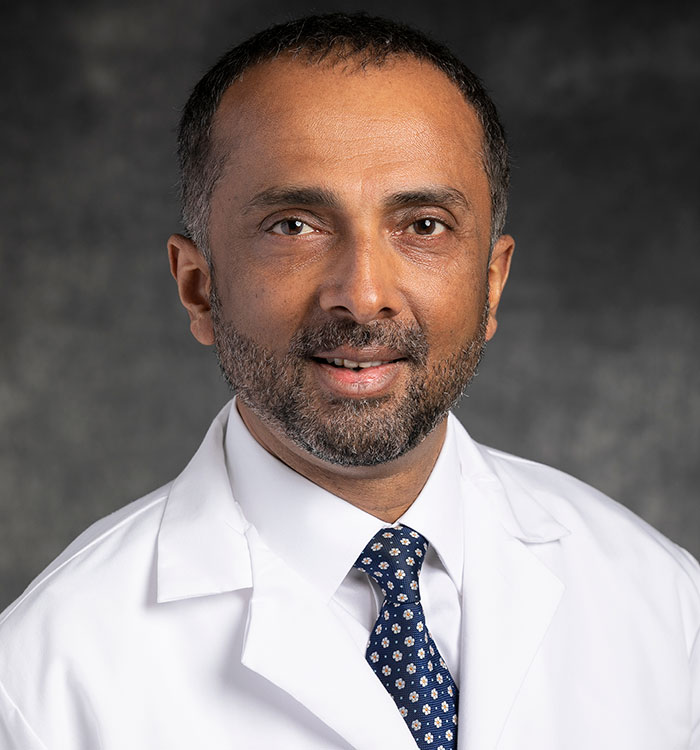Chief Quality Officer Takes Multifaceted Approach at UH Harrington Heart & Vascular Institute
April 22, 2024
UH Clinical Update | April 2024
Ravi Ramani, MD, is quick to point out that the recent transformation of cardiovascular care across the University Hospitals system is a team effort.
 Ravi Ramani, MD
Ravi Ramani, MDStill, it is he who must receive a great deal of credit for so many measurable improvements, says Mehdi Shishehbor, DO, MPH, PhD, President of UH Harrington Heart & Vascular Institute and the Angela and James Hambrick Chair in Innovation, who nominated him for the “Cliff Appreciates/Dinner with the Doc” award he recently received.
“As Clinical Chief, he has worked tirelessly to enhance clinical operations at UH Cleveland Medical Center, with greatly improved cardiology consultations, reduced transfer times from other hospitals for the sickest patients and increased patient volumes, all with improved cardiovascular outcomes,” says Dr. Shishehbor.
And it was only three years ago that Dr. Ramani joined UH after being recruited for the role of Chief Quality Officer at UH Harrington HVI. While there had always been someone in charge of quality, Dr. Ramani’s role perfectly added his combined skills, knowledge and experience as a physician with his vision to create positive change.
The result: UH this year has posted the best ever results in interventional cardiology, in cardiac surgery, in cardiac transplantation and in ventricular assisted devices.
Dr. Ramani graduated from the Armed Forces Medical College in Pune, India before he moved to the U.S. and did his residency in internal medicine at Albert Einstein Medical School in New York. This was followed by a cardiology fellowship and then an advanced heart failure/transplantation fellowship at the University of Pittsburgh Medical Center (UPMC). In 2018, he became the Associate Chair of Quality at the UPMC Heart and Vascular Institute. He joined UH in 2021 to both help lead quality efforts for UH Harrington HVI and run clinical operations for cardiology.
How has he led the achievements at UH Harrington HVI, in a relatively short time?
“I would definitely emphasize that it’s a team effort, with a lot of people playing a role from the top down, from receiving support from leadership and the rest of HHVI, and the nursing and janitorial staff,” Dr. Ramani explains. “We worked to make sure that everyone was a part of the solution – by encouraging people to speak freely, to come up with ideas and discuss them. If those ideas made sense to the group, then we implemented them. We also emphasized the speak-up culture, as well as systemness over silos.”
Transparency and fairness are key. Weekly reports are shared from each UH Harrington HVI location, which show if there have been any quality issues so that necessary changes can be recommended.
For example, Dr. Ramani and his team worked with other UH leaders to identify bottlenecks in the transfers to main campus from outside facilities. “It had to do with bed capacity and communication between referring and receiving physicians,” he says. “Sometimes there was no bed availability at UH Cleveland Medical Center, so we worked on that.”
Another example: If a patient was brought to the ED and experienced a delay in care it could be a cardiology issue, or an EMS issue, or something else, says Dr. Ramani. “So how do you work with all of them, how do you bring people together to solve this, and which people need to come together?”
One solution was to put a dedicated staff in place – fellows and nurse practitioners – who would proactively go to the ED to see if they could identify which patients need to be admitted, which needed expedited testing, or whether some could be safely sent home.
Regarding bed availability, Dr. Ramani says, “We might work with the transfer center and find out there is no (cardiac) bed availability at UH Cleveland Medical Center, so we look at how does that process work, what do you do to make beds available and if there’s a problem, how do you fix that? We had to identify the specific bottlenecks in bed availability and bed capacity, and improving communication between referring and receiving physicians was part of that.”
But it took more than that. “We worked with leadership to help designate beds for critically ill cardiovascular patients, we also worked to see if there was a problem in getting patients out and discharged in a timely manner. We wanted to know if it was a problem in getting the necessary testing done that was holding patients longer than necessary.”
It turned out that some of those patients could be transferred to UH community hospitals near their homes, where they’d also be closer to family and loved ones.
Transparency and sharing data and information are crucial, Dr. Ramani says. And most often, what is perceived to be a “people” problem turns out to be a “process” problem, which data collection might help reveal.
“We also now have physician reports that tell each doctor exactly how they are doing, and how they compare to their peers,” says Dr. Ramani. “We measure on their procedural outcomes. This is all confidential, and there is nothing punitive about it – it just allows physicians to see how they are doing on a regular basis, compared to the system as a whole.”
Congratulations to Dr. Ramani on his “Dinner with the Doc” honor.


